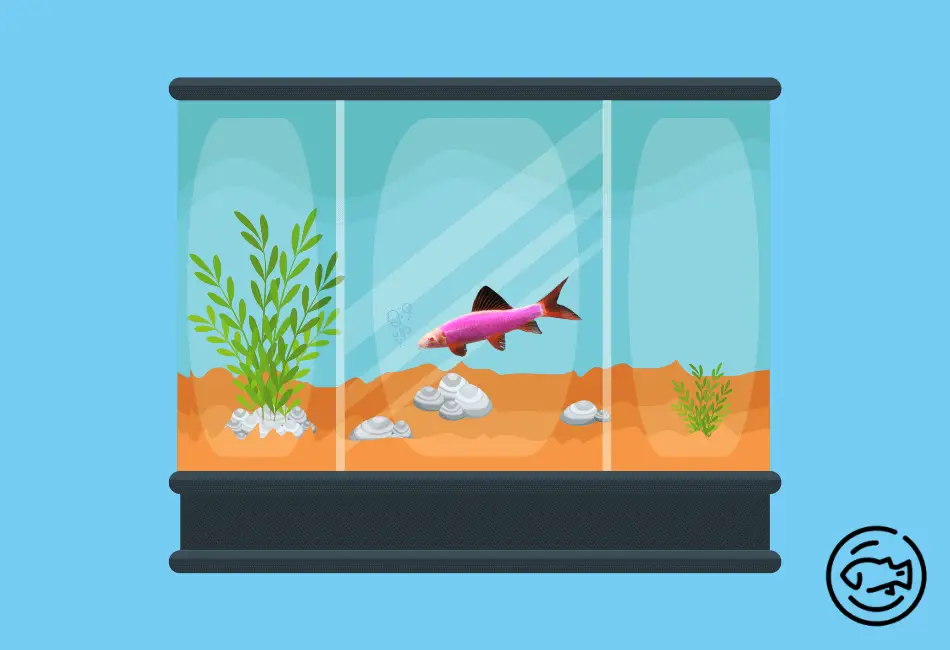They are attractive fish, with their bright colors and interesting patterns. But there is more to keeping these new fish than aesthetics; they require proper care to thrive.
This guide will cover everything you need to know about caring for Glofish Sharks, including their habitat, diet, tank mates, and more.
What Are Glofish?
GloFish is a type of freshwater fish that has been genetically modified to give them an amazing glowing color.
You can get these awesome-looking guys in many different colors like:
- Electric Green
- Starfire Red
- Cosmic Blue
- Sunburst Orange
- Moonrise Pink
- Galactic Purple
Glo-Fishes come with patented breeding technology, so they’re highly sought after by many fish keepers all over the world in the aquarium hobby!
What Are Glofish Sharks?
GloFish and rainbow sharks are both beautiful fish that need similar care.
You should take them out of their tanks to clean off any dirt or algae when you notice it accumulating on the surface, but other than this, they’re easy enough keepers!
Glofish sharks are artificially created variants of the rainbow shark, and you won’t see these fish in nature. And they have a scientific name – Epalzeorhynchos frenatum.
The rainbow shark is one of the most colorful fishes in our world.
Only a few rainbows are left in the world, and they live deep inside rivers that flow through Indochina, where they have decreased due to habitat destruction and pollution that affects their ability to reproduce successfully.
The IUCN has not yet included this species on its Red List, but it may appear on the list as there haven’t been enough observations of them.
Habitat

Glofish Sharks are also known as Rainbow Sharks which are native to Southeast Asia and can be found in various habitats, from rivers and streams to lakes and ponds.
They typically inhabit murky waters in the wild with little to no current.
When choosing a tank for your Glofish Shark, it is important to replicate their natural environment as closely as possible.
A 50-gallon aquarium is a good size for a single fish, and you will need to add more space if you plan on keeping more than one shark.
The tank should have a filter and a heater set to 78-82 degrees Fahrenheit.
Diet
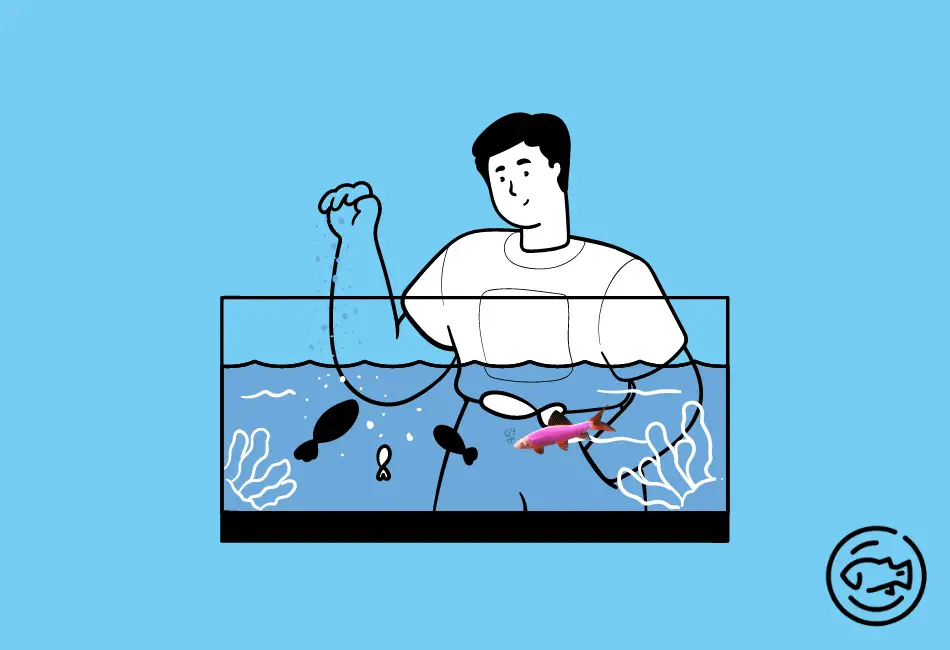
Glofish Sharks are opportunistic bottom feeders in the wild and eat various leftover food, including insects, crustaceans, and small fish.
In captivity, they should be fed a diet of high-quality pellets or flakes designed for predatory fish.
They should also be regularly given frozen or live foods such as brine shrimp, bloodworms, and daphnia.
Tank Mates
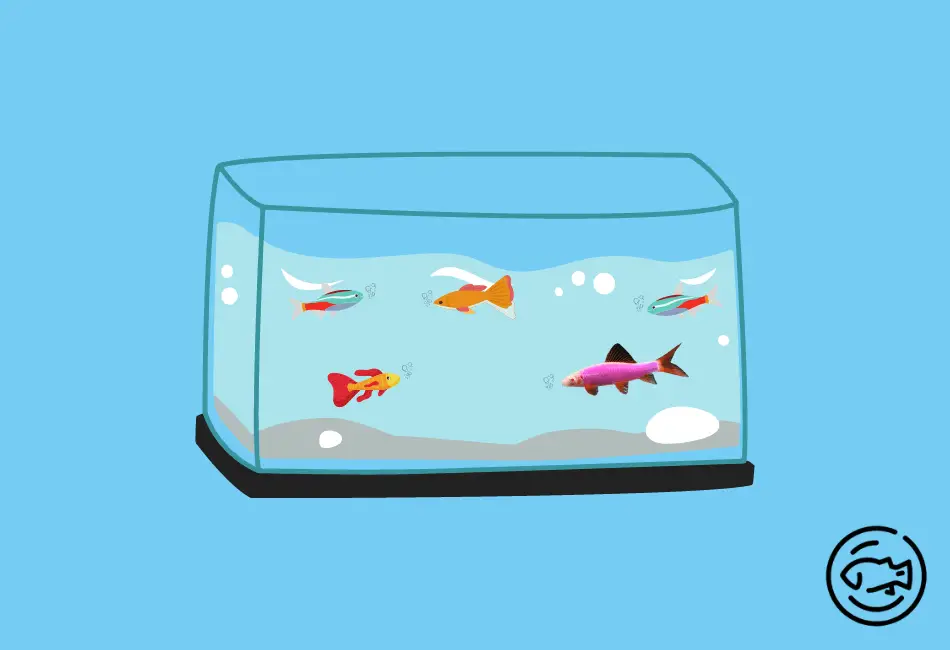
Glofish Sharks are not particularly aggressive fish, but they should not be kept with smaller fish that they may view as prey.
Good tank mates for Glofish Sharks include other peaceful freshwater fish like Neon Tetras, Guppies, and Mollies.
It is also important to ensure that any fish you keep with your shark can tolerate the same water parameters.
Breeding

Glofish sharks are egg-laying species, but they can be very difficult to breed.
Due to their territorial personality, holding multiple sharks in the same aquarium can be problematic.
It can also be tough to tell male and female sharks apart until they reach adulthood, which is around 4 inches in size.
Male glofish sharks have thinner bodies, and females have black lines and tail fins.
Males also tend to be more vibrant in color, but as with all glofish, there is a patent on them so that you can reproduce them in your home aquarium, but you cannot legally sell or trade them.
Decoration
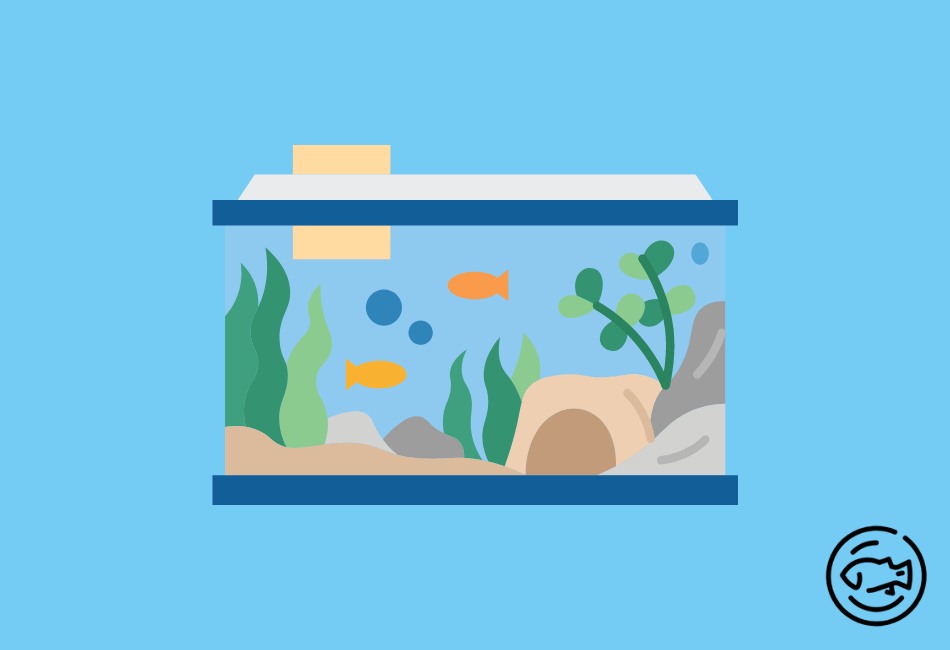
Since Glofish Sharks come from murky waters in the wild, they prefer a dimly lit tank with plenty of hiding places.
Live plants can be used to create a naturalistic environment, and driftwood or rocks can be added for hiding places.
It is also best for them if you add a fine gravel or sand layer to the bottom of the tank as it won’t cause them any injury when they swim around on the floor of the tank.
Water Conditions
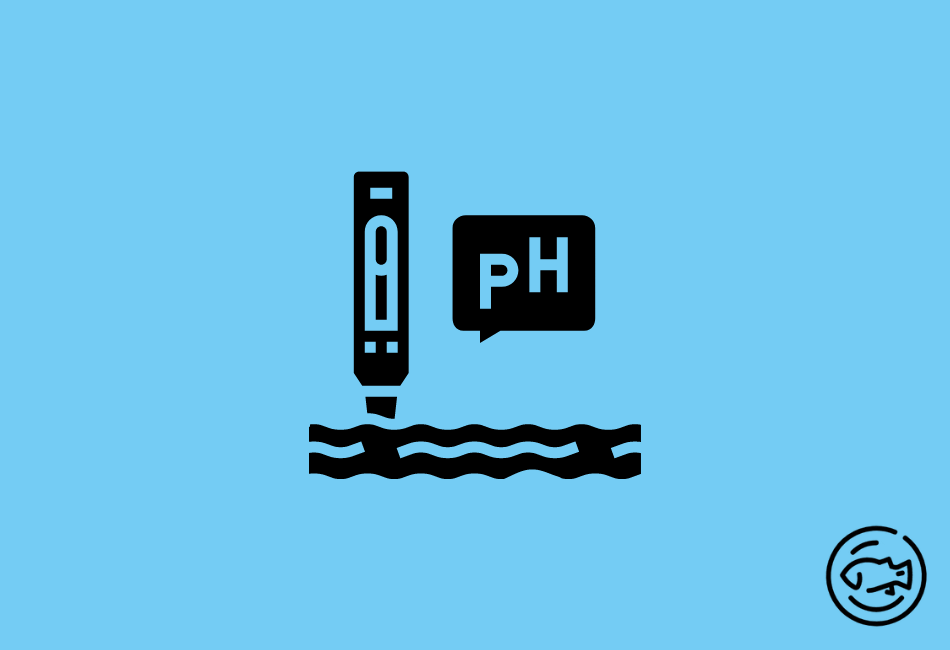
Glofish Sharks are tropical fish and prefer warm water with little to no current.
The ideal water temperature for a Glofish Shark tank is 78-82 degrees Fahrenheit, and the pH should be between 6.5 and 7.5.
It is also important to perform regular water changes to keep the water clean and free of toxins so that water hardness is maintained between 5 to 11 dkH.
Lighting
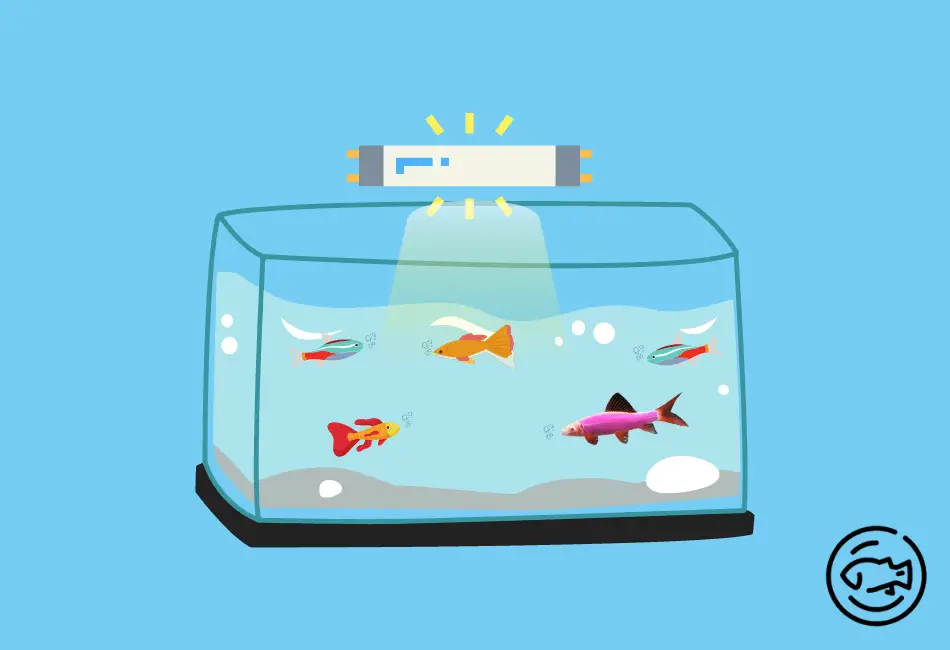
Since Glofish Sharks come from murky waters in the wild, they prefer a dimly lit tank as they are fluorescent fish.
A fluorescent aquarium light will provide the necessary light for live plants and help show off the sharks’ bright colors.
Filtration

It is important to choose a filter that is appropriate for the size of your dirty tanks and the number of fish you have.
A good rule of thumb is to choose a filter that can turn over the entire volume of your tank clean at least once per hour. For a 50-gallon tank, a canister filter or an internal power filter would be a good choice.
Also Read: What Is A Misbar Clownfish – Meaning, Breeding & More!
Are Glofish Sharks Good for Beginners?
It can be good for beginners if they choose an easy glofish shark species as their first fish. This is because they are easy to take care of and low-maintenance, depending on the species you choose.
They are also hardy fish, which means they can live in poor water parameters. However, they need a lot of space since they can grow up to 6 to 7 inches long.
Glofish Shark Care Guide
To take care of a glofish shark, you will need to do the following:
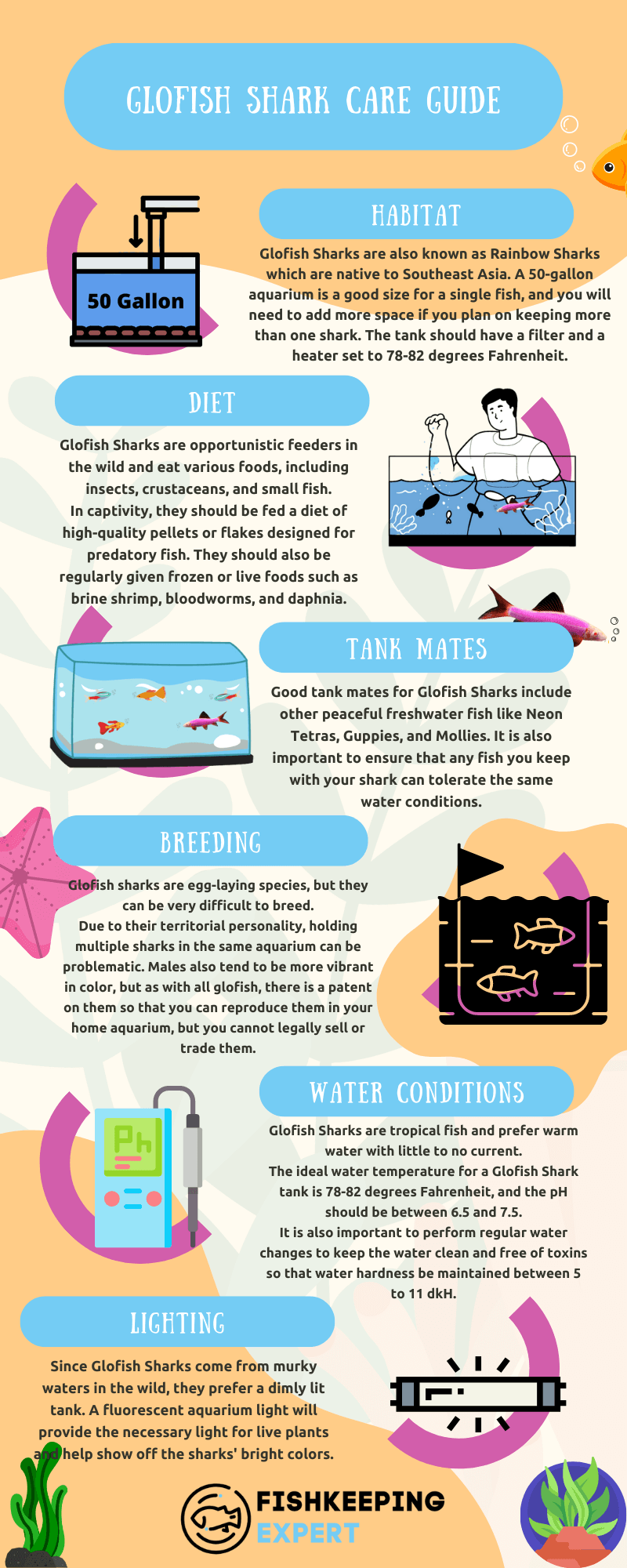
1. Get a tank that is at least 50 gallons. An aquarium with 50 gallons is the minimum size you should get for a glofish shark. This is because they need a lot of space to swim and grow.
2. Put sand or gravel at the bottom of the tank. This will help to create a natural environment for your glofish shark.
3. Decorate the aquarium with rocks, plants, and other hiding places. This will help make your glofish shark feel more comfortable in its new environment.
4. Install a filter and a heater in the aquarium. The filter will help keep the water clean, and the heater will help keep the water at a consistent temperature.
5. Add a glofish shark to the tank. If you want to add at least two glofish sharks to the aquarium, then you should add more gallons to your tank to create room for these territorial fish as they do not go along well together.
6. Feed your glofish shark a diet of brine shrimp, bloodworms, and flakes. It would be best to feed your glofish shark 2-3 times a day.
7. Change the water in the aquarium every week. This will help to keep the water clean and free of toxins.
8. Monitor the temperature and pH levels of the water. The water temperature should be between 72-78 degrees Fahrenheit, and the pH levels should be between 7.0-8.0.
9. Take your glofish shark to the vet for regular checkups. Taking your glofish shark to the vet for regular checkups is important to ensure they are healthy and to catch any problems early.
What Are The Benefits Of Keeping A Glofish Shark?
There are many advantages to keeping a glofish shark. The following are the benefits of keeping a glofish shark:
- They are beautiful fish that add color and interest to your aquarium.
- They are relatively easy to care for, as long as you provide them with the proper environment and diet.
- They are peaceful fish that get along well with other fish mates.
- They are hardy fish that are not easily sickened by poor water parameters.
What Are The Challenges Of Keeping A Glofish Shark?
While there are many benefits to keeping a glofish shark, there are also some challenges that you should be aware of:
- They require a large aquarium. A minimum tank size of 40-50 gallons is recommended.
- They are active swimmers and need plenty of room to swim.
- They are known to be jumpers, so a tight-fitting lid is essential.
- They are sensitive to changes in water conditions and need to be acclimated slowly to new tanks.
- They are susceptible to ich and other diseases, so regular water changes and good tank maintenance are essential.
If you are prepared to meet the challenges of keeping a glofish shark, this fish can make a beautiful and interesting addition to your aquarium.
What Do Glofish Sharks Eat?
A glofish shark’s diet consists mostly of small fish, but they will also eat shrimp, crabs, and other small invertebrates.
They are not picky eaters, but it is important to offer a variety of foods to ensure they get all the nutrients they need.
Can Glofish Sharks Live Together?
When two glofish sharks are kept together, the juveniles will usually avoid each other.
However, as these fish mature and grow up, they become more aggressive towards their surroundings. This attitude changes drastically, with them being best suited for single specimens after maturity.
Glofish are not naturally shoaling fish, and they will attack others of their kind. If you decide to keep a pair together, there’s no need for a small tank as each requires at least one square meter per fish space, which means you will need a very large tank.
What Is The Difference Between A Glofish And A Regular Shark?
There are several differences between glofish and regular sharks.
For one, glofish are bred in captivity while regular sharks are caught in the wild. This means that glofish are used to being around humans and are less likely to attack them.
Regular sharks also need more space than glofish sharks since they can grow up to 20 feet long.
They also need to be in a saltwater tank, while glofish can live in salt and freshwater tanks.
Common Diseases For Glofish Shark?
The following are the diseases your Glofish shark could be susceptible to and how to treat them.
1. Neon Tetra Disease (NTD)
Neon Tetra Disease is caused by a parasitic infection of the nervous system and can affect any fish in the aquarium, not just neon tetras. The parasite affects the fish’s ability to swim and breathe properly, eventually leading to death.
If you suspect that your fish has NTD, remove it from the main tank immediately and place it in a clinic tank.
The best treatment for NTD is to raise the temperature of the water to 86 degrees Fahrenheit for two weeks.
This will kill the parasite, but unfortunately, it will also kill your fish if it is not treated in time.
2. Ich (Ichthyophthirius Multifiliis)
Ich is a common parasitic infection affecting freshwater and saltwater fish. The parasites attach themselves to the fish’s skin and cause white spots to form. If left untreated, ich can lead to death.
To treat ich, raise the temperature of the water between 82-86 degrees Fahrenheit for three to four days.
This will kill the parasites, and hopefully, your glofish shark will be treated in time.
3. Fin Rot (Aeromonas Hydrophila)
Fin rot is a bacterial infection that affects the fins and tail of the fish. The infection starts as a small lesion on the fins and quickly spreads. If left untreated, fin rot can lead to death.
To treat fin rot, remove the infected fish from the main tank and place it in a sanitarium tank, to keep other fish safe in case your fish died.
Then, add one teaspoon of salt per gallon of water to the tank. The salt will help kill the bacteria and speed up the healing process.
4. Swim Bladder Disease (SBD)
Swim bladder disease is a condition that affects the fish’s ability to swim properly.
The disease is caused by a build-up of gas in the fish’s stomach, which makes it buoyant and causes it to float upside down. If left untreated, this disease can lead to death.
To treat Swim Bladder Disease, remove the affected fish from the primary tank and place it in an infirmary tank.
Then, add one teaspoon of salt per gallon of water to the hospital tank. The salt will help expel the gas from the fish’s stomach and make it swim properly again.
5. Dropsy (Edema)
Dropsy is a condition that causes the fish’s body to swell up with fluid. The condition is caused by a build-up of toxins in the fish’s body, and if left untreated, it can lead to death.
To treat dropsy, remove the affected fish from the primary tank and place it in a clinic tank.
Then, add one teaspoon of salt per gallon of water to the tank. The salt will help expel the toxins from the fish’s body and reduce the swelling.
Conclusion
Glofish sharks are beautiful new fish that can make a great addition to your aquarium. However, they are also challenging fish to keep and require some special care.
Glofish is the new fish added to the ever-growing glofish family of genetically modified creatures. These bright, colorful creatures have been created by tweaking their genes in order for them to glow under light sources like aquarium lights or the sun.
The neon fish is not for everyone, but they can be a great addition to any tank. They’re easy enough that even beginners will have no problem taking care of them!
Glofish are some of the hardiest fish out there, but they also have very specific care requirements. If you don’t know what type to keep with them, then this could be a drawback for your tank setup because not all species will get along well together!
If you are prepared to meet the challenges of keeping fish, this Glofish Shark can make a beautiful and interesting addition to your aquarium.


